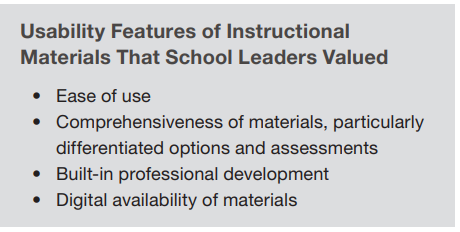What is the principal’s role in selecting and implementing materials? The RAND Corporation’s study titled, School Leader’s Role in Selecting and Supporting Teachers’ Use of Instructional Materials, answers that question. The study explored how the COVID-19 pandemic has impacted school leaders’ perception of materials’ quality, as well as their role in selecting and implementing instructional materials.
The study was based on qualitative, semi-structured interviews with 39 school leaders who were part of the RAND Corporation’s American School Leader Panel. Though a relatively small group, the survey respondents included school leaders across the country from schools that were diverse in terms of the grade levels served and student demographics.
The study found that even though instructional materials are typically selected by the school district, principals’ perception of materials matter because school leaders heavily influence teachers’ use of instructional materials. Principals show support for or indifference to materials in several ways, including through teacher evaluations and their allocation of resources for professional development and planning time. So what features do principals consider indicators of high quality in a material?
The study first asked the school leaders open-ended questions about what they thought “good” instructional materials include. They were then asked for their thoughts about the following seven dimensions of instructional materials:
(1) standards alignment: degree to which material are aligned to state and/or college-and-career readiness standards;
(2) appropriateness of challenge: degree to which material address the academic and learning needs of students, including supports for differentiation and accessibility,
(3) engagement: degree to which materials are likely to be engaging or compelling for students;
(4) usability: degree to which materials are comprehensive and easy for educators to implement or adapt;
(5) cultural relevance: degree to which the materials include content and approaches that are culturally relevant, particularly to Hispanic and Black students;

(6) language acquisition supports: degree to which materials include supports for English learners (ELs); and
(7) social-emotional learning supports: degree to which materials include content and approaches that promote social and emotional learning.
Prior to the COVID-19 pandemic, principals prioritized two dimensions that facilitated teachers’ use of a material, usability and standards alignment, as the most important indicators of a material’s quality. However, the pandemic expanded the features principals assess when gauging a material’s quality. Since the pandemic, principals are likely to look for additional features in materials, including online accessibility, social-emotional supports and technology integration capabilities.

- Interestingly, prior RAND studies found that district administrators focused primarily on materials’ alignment to policy/standards, and teachers focused on whether materials would engage, challenge, and be easy for their students to use.
Overall, the school leaders perceptions of indicators of quality were not significantly affected by differences in grade levels served by or demographics of their school. However, more elementary principals and principals of schools with a high percentage of students performing below grade level prioritized appropriateness of challenge and engagement as indicators of quality. Similarly, more middle school leaders and principals of schools with a high percentage of Hispanic and Black students gave prioritized cultural relevance as an indicator of quality.
The school leaders were also asked about what process they use to select materials. The study found that when assessing the quality of instructional materials, school leaders prioritize feedback from teachers and colleagues who have used the materials. Few principals reported using rubrics with published criteria to select materials.
When asked about the type of guidance they give to support teacher buy-in for newly selected instructional materials, some of the respondents mandate the use of district materials and monitor the fidelity of implementation, while others encourage teachers to modify or deviate from their materials. However, most principals surveyed try to strike a balance between fidelity of implementation and teacher autonomy. The majority also emphasized the role of lead teachers and/or instructional coaches in supporting successful implementation.
The report concludes with the following recommendations for district leaders:
(1) District leaders, school leaders, and teachers should participate in the selection of district instructional materials, since each stakeholder group has a different perspective about instructional materials, and an inclusive selection process fosters buy-in.
(2) Rubrics or written criteria should be used to review materials in order to achieve consistency and transparency in the review process.
(3) Districts should provide principals with professional development about the district-adopted/recommended materials because “[i]f school leaders understand adopted curriculum deeply, they will understand which aspects of the curriculum are flexible and which aspects are important to maintain in order to guarantee student learning.”
Learning List’s new online Selection Toolkit makes it easy to for districts to implement those recommendations.
